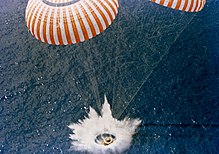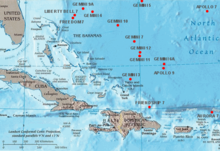
Back Amaratge de naus espacials Catalan Wasserung German Amerizaje Spanish آبفرود Persian Splashdown Finnish Splashdown (astronautica) Italian 스플래시다운 Korean स्प्लॅशडाउन Marathi Wodowanie (lotnictwo) Polish Amaragem Portuguese



Splashdown is the method of landing a spacecraft or launch vehicle in a body of water, usually by parachute. This has been the primary recovery method of American capsules including NASA’s Mercury, Gemini, Apollo and Orion along with the private SpaceX Dragon. It is also possible for the Boeing Starliner, Russian Soyuz, and the Chinese Shenzhou crewed capsules to land in water in case of contingency. NASA recovered the Space Shuttle solid rocket boosters (SRBs) via splashdown, as is done for Rocket Lab's Electron first stage.
As the name suggests, the vehicle parachutes into an ocean or other large body of water. Due to its low density and viscosity, water cushions the spacecraft enough that there is no need for a braking rocket to slow the final descent as is the case with Russian and Chinese crewed space capsules or airbags as is the case with the Starliner.[1]
The American practice came in part because American launch sites are on the coastline and launch primarily over water.[2] Russian launch sites such as Baikonur Cosmodrome are far inland, and most early launch aborts would descend on land.
- ^ Tous, Marcos (June 28, 2024). "The science behind splashdown—aerospace engineer explains how NASA and SpaceX get spacecraft safely back". The Conversation. Retrieved November 27, 2024.
- ^ "Launch Services Program Launch Sites". NASA. May 14, 2009. Retrieved August 7, 2020.